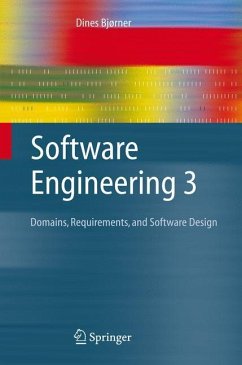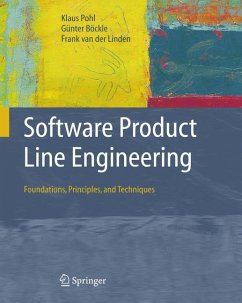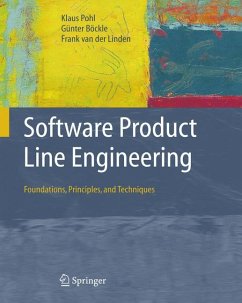
Software Engineering 3
Domains, Requirements, and Software Design
Versandkostenfrei!
Versandfertig in 1-2 Wochen
76,99 €
inkl. MwSt.
Weitere Ausgaben:

PAYBACK Punkte
38 °P sammeln!
The art, craft, discipline, logic, practice and science of developing large-scale software products needs a professional base. The textbooks in this three-volume set combine informal, engineeringly sound approaches with the rigor of formal, mathematics-based approaches.
Advocating a novel approach based on understanding the application domain before formulating the requirements, the book takes the reader from the principles and techniques for the development of domain descriptions, via principles and techniques for the derivation of requirements prescriptions from domain models, to principles and techniques for the refinement of requirements into software designs: architectures and component design.
Focusing only on the informal parts, this book targets undergraduate students in courses on software engineering and college lecturers in that field, while the full version of the book also targets advanced students, lecturers and researchers.
Advocating a novel approach based on understanding the application domain before formulating the requirements, the book takes the reader from the principles and techniques for the development of domain descriptions, via principles and techniques for the derivation of requirements prescriptions from domain models, to principles and techniques for the refinement of requirements into software designs: architectures and component design.
Focusing only on the informal parts, this book targets undergraduate students in courses on software engineering and college lecturers in that field, while the full version of the book also targets advanced students, lecturers and researchers.
The art, craft, discipline, logic, practice, and science of developing large-scale software products needs a believable, professional base. The textbooks in this three-volume set combine informal, engineeringly sound practice with the rigour of formal, mathematics-based approaches.
Volume 3 is based on the maxim: "Before software can be designed its requirements must be well understood, and before the requirements can be expressed properly the domain of the application must be well understood." This book covers the process from the development of domain descriptions, via the derivation of requirements prescriptions from domain models, to the refinement of requirements into software designs, i.e., architectures and component design. Emphasis is placed on what goes into proper domain descriptions and requirements prescriptions, how one acquires and analyses the domain knowledge and requirements expectations, and how one validates and verifies domain and requirements models.
The reader can take an informal route through Vol. 3, and this would be suitable for undergraduate courses on software engineering. Advanced students, lecturers, and researchers may instead follow the formal route through Vol. 3, and in this case Vol. 1 is a prerequisite text. Lecturers will be supported with a comprehensive guide to designing modules based on the textbooks, with solutions to many of the exercises presented, and with a complete set of lecture slides.
Volume 3 is based on the maxim: "Before software can be designed its requirements must be well understood, and before the requirements can be expressed properly the domain of the application must be well understood." This book covers the process from the development of domain descriptions, via the derivation of requirements prescriptions from domain models, to the refinement of requirements into software designs, i.e., architectures and component design. Emphasis is placed on what goes into proper domain descriptions and requirements prescriptions, how one acquires and analyses the domain knowledge and requirements expectations, and how one validates and verifies domain and requirements models.
The reader can take an informal route through Vol. 3, and this would be suitable for undergraduate courses on software engineering. Advanced students, lecturers, and researchers may instead follow the formal route through Vol. 3, and in this case Vol. 1 is a prerequisite text. Lecturers will be supported with a comprehensive guide to designing modules based on the textbooks, with solutions to many of the exercises presented, and with a complete set of lecture slides.













